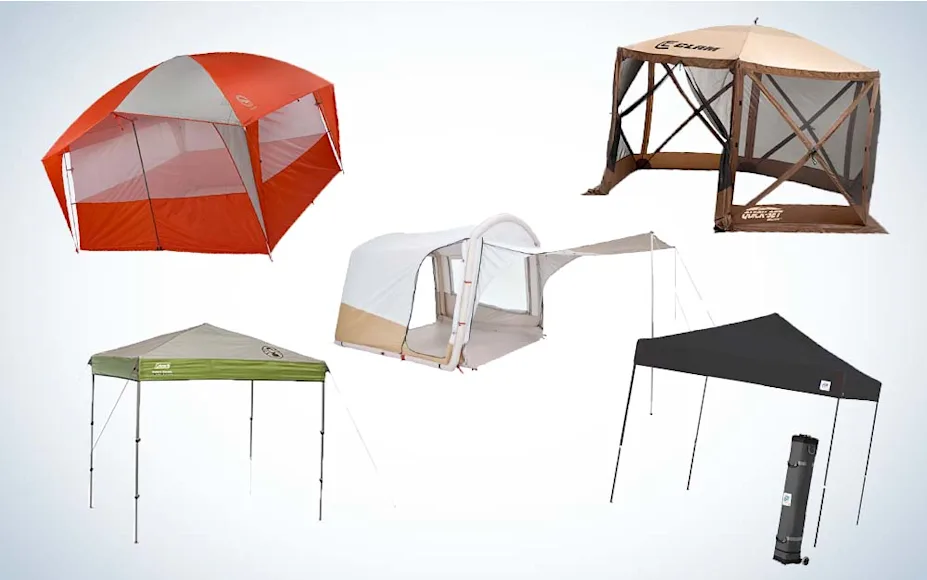_We may earn revenue from the products available on this page and participate in affiliate programs. Learn more ›
_
Best Overall
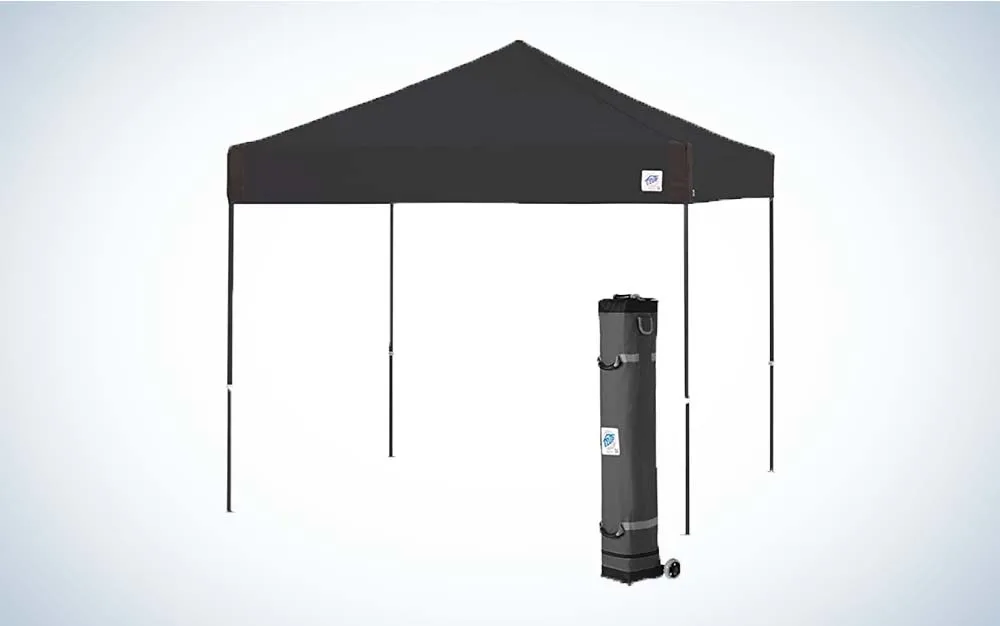
EZ UP Pyramid
Best for Wind

Clam Escape Screen Tent
Best Budget
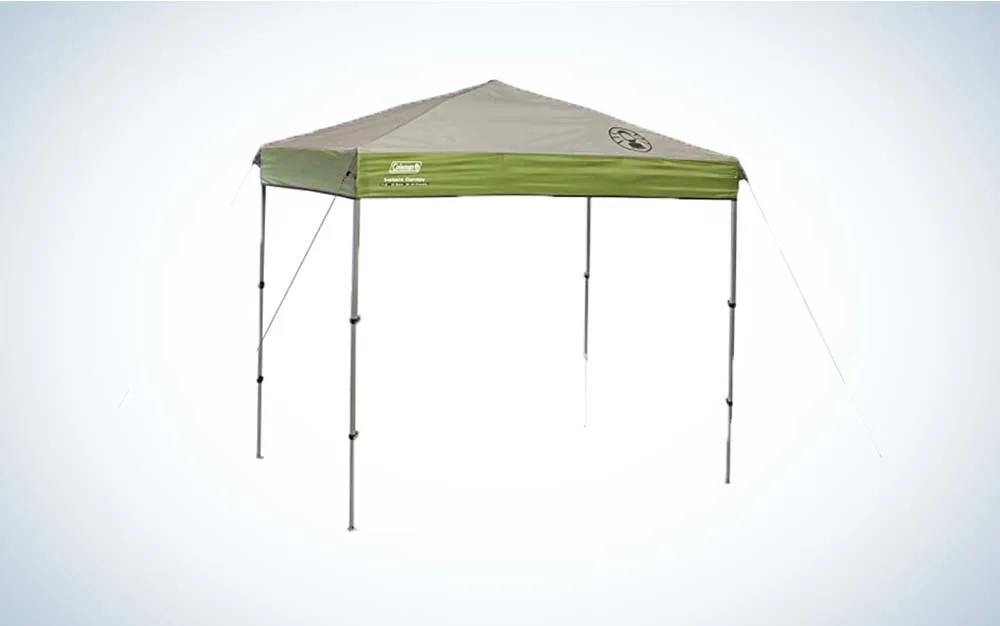
Coleman Instant Canopy
Canopy tents provide a quick and protective shelter to get out of the elements. These versatile structures are used for a wide range of activities. When choosing a canopy tent, the first task is to consider its purpose. While we are focusing on outdoor canopy tents for the campground, beach, or backyard, it’s worth noting that canopy tents can be used for much more. This includes residential use as a semi-permanent structure, commercial use at a job site, emergency use for disaster relief, as well event shelters at weddings, festivals, and trade shows.
Like any piece of outdoor gear, choosing the right canopy tent comes down to personal preference and meeting your specific needs. Before jumping down to our top picks, read through our buyer’s guide. There, you’ll discover the things you need to know to find the best canopy tents.
Best Overall: EZ UP Pyramid
Best Outdoor: Big Agnes Sugarloaf Shelter
Best Car Canopy: Kelty Backroads Shelter
Best with Sides: Decathlon Inflatable Living Room
Best for Beach: Shibumi Shade
Best for Wind: Clam Escape Screen Tent
Best Budget: Coleman Instant Canopy
How We Picked the Best Canopy Tents
As an outdoor adventurer, canopy tents play an essential role in my comfort in the outdoors. I use them to work on backyard projects out of the sun, shade the family at the beach, and protect our camp kitchen from bugs and rain. I’ve personally experienced the good and bad through my own trial and error.
When looking for the best canopy tents, I researched dozens of well-established companies and personally tested them in order to reach my conclusions. I evaluated products using the following criteria:
Quality: I chose canopy tents that were durable and reliable. These picks should last many years. In addition, most of these come with some warranty.
Innovation: While the standard 10 x 10 ft canopies all look the same at first, there’s a difference in the details that will make or break your experience. For example, the EZ Up’s comfort grip and dependable wheeled tote bag make all the difference when carting nearly 50 lbs down to the beach. The Clam Escape’s almost instant assembly process will be a godsend when you’re racing the clock against hungry mosquitos, and the full sides panels on the Kelty Backroads Shelter will give full protection from a sudden sideways rainstorm.
The Best Canopy Tents: Reviews & Recommendations
Best Overall: EZ UP Pyramid

Key Features
Weight: 48 pounds
Open Dimensions (L x W x H): 10 ft x 10 ft x 10 ft 5 in
Packed Dimensions: 62 x 8 x 9 inches
Materials: Alloy steel poles, polyester canopy
Pros
Easy set up
Roller bag storage and transport
3-year warranty
Cons
Heavy
The EZ Up Pyramid is a standard in pop-up tents for good reason. This versatile canopy is great for everything from a day at the beach to picnic table shade or a temporary backyard awning. Starting with storage, the EZ Up has a burly roller bag with a grip handle which makes the heavy tent portable.
Setting up the EZ Up Pyramid is fairly easy, though two people are required. A nice feature of this pop-up is the three available height settings. With the maximum height setting at 10 feet, 6 inches, it is one of the tallest canopy tents we tested. This shelter has a 10 x 10 footprint, however, it comes in a 12-foot option as well. For those seeking additional features, EZ Up sells some really useful accessories, including a screen room
attachment, sidewall
, and stake kit
.
This canopy tent is reliable and user-friendly, but has its limits. While the roof is water-resistant, it is not our best pick for wind and rain. Water tends to pool on the canopy under heavy rainfall, which can cause collapse. In addition, this did not handle high winds as well as some of our other portable tent canopies.
Best Outdoor: Big Agnes Sugarloaf Shelter

Key Features
Weight: 14 pounds
Open Dimensions (L x W x H): 10 ft x 10 ft x 7.3 ft
Packed Dimensions: 27.5 x 16.8 x 7.8 inches
Materials: Aluminum poles, polyester canopy, mesh body
Pros
Versatile
Removable screen tent
Rain, wind, bug, and sun protection
Cons
Expensive
If you are looking for a canopy tent that will protect against sun, rain, and bugs, this is your best bet. Built for outdoor use, the Big Agnes Sugarloaf Shelter is the perfect camping companion. It can be used as a screen tent or a 10 x 10 shaded canopy.
While it is possible to set it up solo, it’s much easier with two people. Once staked, it can handle an impressive amount of wind and rain. The bottom of the screen house has mud flaps that stake out to prevent dirt, sand, and critters from entering through the bottom.
The screen house portion is half mesh/half poly taffeta fabric. Ventilation is good, and the one large door can be tied back as an opening. Without the screen tent portion, it stands alone as a solid 10 x 10 ft sunshade. The curved pitch of the roof prevents water from pooling, like we saw on the EZ Up. As one of the most expensive options on our list, this canopy tent is for those needing a dependable shelter for frequent use and protection from the elements.
Best Car Canopy: Kelty Backroads Shelter
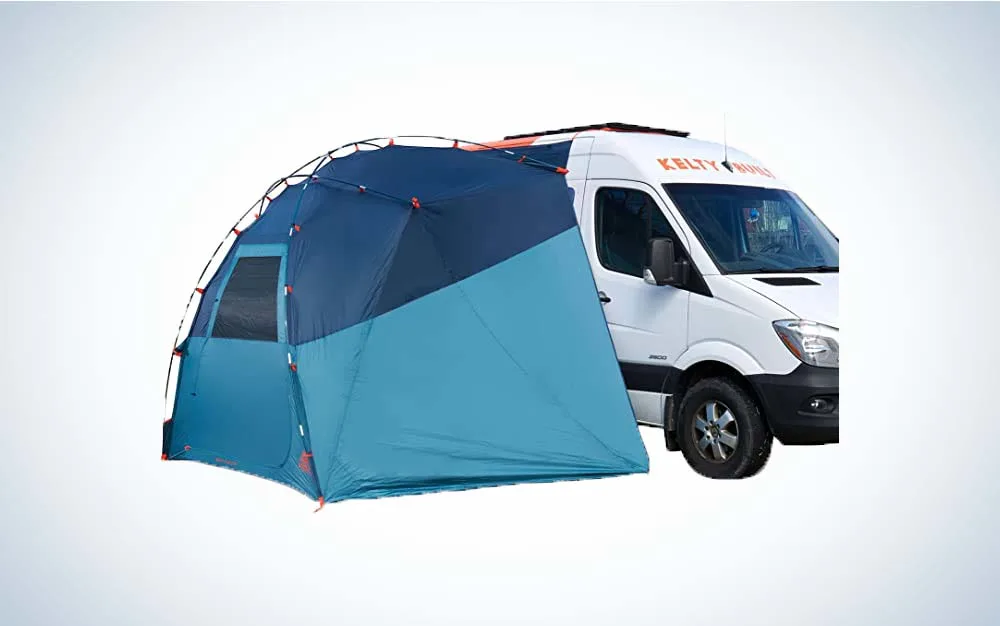
Key Features
Weight: 11 pounds
Open Dimensions (L x W x H): 11.5 ft x 6 ft x 8 ft
Packed Dimensions: 25 x 7.5 x 7.5 inches
Materials: Fiberglass poles and polyester canopy
Pros
Affordable
Full coverage rain and wind protection
Compatible with a wide range of vehicles
Cons
Needs vehicle for assembly—does not stand alone
The Kelty Backroads Shelter is perfect for car camping or tailgating. The easy setup allows users to attach a sizable tent to a range of vehicles, including small SUVs, jeeps, and campervans. Setting up this car canopy was easy and could be done by one person. The tent straps attach to your roof rack and stakes to the ground. It is light and easily portable in a small duffle.
The real innovation of this canopy is the optional full-side walls. While there are many attachable car canopy awnings, this shelter has the option to drop to full side coverage—giving the user both privacy as well as protection against wind and rain. The back has a zippered “D door” and windows for easy ventilation. At peak height, adults can stand straight up in the 8-foot shelter, but the dome roof does eliminate some usable standing space. At less than $200, we consider this an affordable and heavy-duty canopy tent for those needing coverage attached to their vehicle.
Best with Sides: Decathlon Inflatable

Key Features
Weight: 28.7 pounds
Open Dimensions: 67.3 ft floor area and 7.3 ft height
Packed Dimensions: 30.3 x 11.4 x 11.4 inches
Materials: Polyester with aluminum ceiling support poles
Pros
Rain and wind resistant
Removable groundsheet
Lightweight and portable
Cons
Not all sides are removable
The Decathlon inflatable living room is a perfect option for a closed canopy. Set up is a fun approach to a camping or backyard shelter. Instead of poles, this sidewall canopy tent depends on inflatable support tubes. To set up, use a hand pump (sold separately) or an electric pump to blow up the side supports. Additional aluminum poles are placed along the ceiling.
This canopy can be used as a stand-alone shelter connected to a tent as an additional living space or partnered with a camper van as a car canopy. The Decathlon living room has sidewalls and an optional (included) floor. Two sides of the canopy can fully open to either attach to a car/tent or provide additional sun protection as an awning. When fully closed, the zippered door works as an entrance. The floor-to-ceiling meshed window allows for excellent ventilation, even when the walls are closed.
Overall, this canopy performed well against rain and wind when fully inflated and staked. With changes in air temperatures/pressure, this would not be a choice for a semi-permanent shelter but instead a great option for camping storage or eating/living space.
Best for Beach: Shibumi Shade
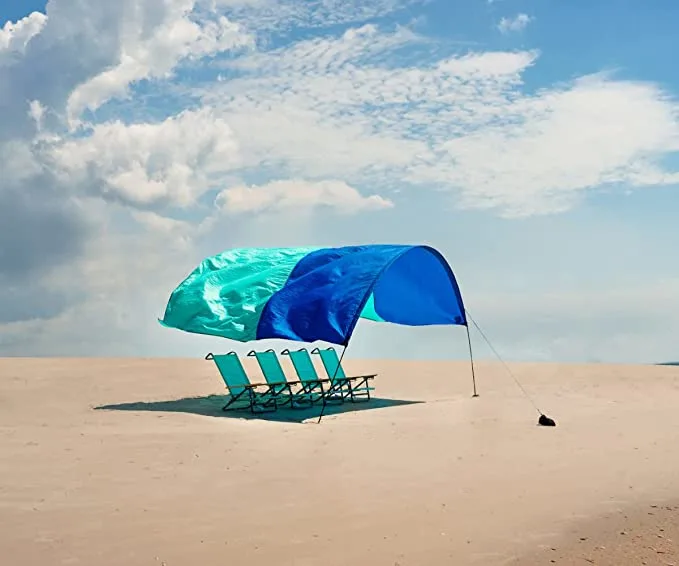
Key Features
Weight: 4 pounds
Open Dimensions (L x W x H): 15 ft x 10 ft x 6.5 ft
Packed Dimensions: 27 x 4 x 4 inches
Materials: Hard-anodized aluminum pole, REPREVE® Our Ocean® polyester fiber made from recycled ocean-bound plastic bottles
Pros
Lightweight and portable
Large coverage area
Easy, one-person set up
Cons
Needs wind to set up
It doesn’t get much lighter or more efficient than this beach canopy. The Shibumi Shade’s innovative structure uses the power of the wind to keep a large flag-like sail flying above your head and producing a sizable rectangle of shade. Assembly is easy and doable for one person. The canopy threads onto a large aluminum pole and forms an arch shape. With a minimum of 3 mph wind, the Shibumi shade provides a 150-foot area of shade. In addition to its simplicity and excellent sun coverage, it’s by far the lightest and easiest carrying case of the canopies we tested. At only 4 lbs, this canopy can slip into your beach bag or be slung over a shoulder, compared to its heavier 40 lb plus pop-up counterparts.
While assembly and take-down are easy, there’s a learning curve to positioning it into the wind correctly. Shibumi also boasts that the canopy is made from Repreve Our Ocean fiber which is made from ocean-bound recycled bottles.
Best for Wind: Clam Escape Screen Tent

Key Features
Weight: 37 pounds
Open Dimensions (L x W x H): 11.5 ft x 11.5 ft x 7.5 ft
Packed Dimensions: 74 x 8 x 8 inches
Materials: Fiberglass poles, 210 Denier Poly-Oxford canopy, mesh sides
Pros
Wind resistant
Easy, one person set up/take down
Screen tent for bugs
Cons
The screen is not removable
The Clam Escape screen tent has a lot going for it. Out of the box, assembly is extremely easy. Users simply need to lay out the shelter and pop out the sides and roof before staking it down. Once set up, you have a solid screen tent and an umbrella-shaped roof. The double door with a zipper ties back to allow easy coming and going. Ground flaps keep critters and dirt from entering.
The crossbeam style sides provide stability against wind. Where other canopy tents turn into a sail in the breeze, this one can brace against it. The roof is water-resistant to rain. For additional wind, sun, and rain protection, customers can purchase the optional full coverage wind side panels
making this also our top pick as a winter canopy tent. And while it comes in green and brown, the brown version comes with an additional built-in roof flap to detour rain over accessory wind panels. Take a look at these winter tents
to pair with your weather-proof canopy.
Best Budget: Coleman Instant Canopy

Key Features
Weight: 43.6 pounds
Open Dimensions (L x W x H): 10 ft x 10 ft x 6 ft 11 inches
Packed Dimensions: 48.8 x 10.2 x 8.27 inches
Materials: Steel Alloy Poles and UVGuard™, water-resistant canopy
Pros
Affordable
Easy to set up
Optional sidewall (sold separately)
Cons
Durability
Not waterproof
If you are in need of an affordable sun shelter, this is a great choice. The Coleman Instant Canopy is an easy two-person set up similar to the EZ Up. It provides 10 x 10 ft coverage against sun and mild weather. For additional wind and sun coverage, customers can purchase the optional sunwall accessory panel
.
This pop-up canopy is on the heavy side. It comes in a handy tote bag but lacks the bells and whistles of the EZ Up wheeled travel bag. While this is a reliable outdoor canopy tent for sun, heavy rain can pool in parts of the roof and lead to damage in the support beams. If taken care of, this budget option can last years. We love it as a picnic cover and temporary shelter from the sun.
What to Consider When Choosing a Canopy Tent
When shopping for the best canopy tents, it’s important to keep a few things in mind. Consider the following:
Size
Canopy tents are meant to provide cover. Make sure you know the area you’d like to cover when choosing a shelter. Here are the three main categories according to size:
Small Canopy Tents: Canopies under 100 square feet. These shelters are great for car camping, beach days, or single-person use.
Medium Canopy Tents: The 10 x 10 ft and 12 x 12 ft canopy tents are perhaps the most common. The 100-square-foot area is enough to fit a standard picnic table beneath. For those in need of a little more room in their camp kitchen or banquet-style table, a 12 x 12 ft is a logical choice.
Large Canopy Tents: Anything that is 10 x 20 ft, 10 x 30 ft, or more is considered a large canopy tent. These tents are most often used as “party tents” and for outdoor functions. Check out our advice on what to consider before buying an extra-large tent
.
Weather
It’s important to consider what kind of weather you need your canopy tent to withstand. Traditional pop-up tents do not fare well in high winds and rain. The roof can become unstable and easily fall or collapse. Similarly, heavy rain can pool on roofs. Look for the following:
Sun: Look for terms like UPF ratings of 50 plus or higher to protect against harsh UV rays.
Rain: Some canopy tents are really only meant as sunshades. The best rainproof canopies have a DWR treatment (you can do this yourself) and sealed seams.
Wind: Securing your canopy tent is the best way to prevent wind collapse. Use provided guy lines, stake it down securely, and take it down when there are high winds to prevent damage. Weighted bags can also be purchased for additional support.
Features
Many canopy tents come with accessories or features that make them more functional and useful. Here are a few to look for:
Sidewalls: Sidewalls protect against the harsh sun, block rain, and provide privacy.
Screen Tent: A screened canopy tent can be an add-on, like the Big Agnes Sugarloaf Shelter, or an integral part of the structure, like the Clam Escape. This is a great feature to keep mosquitos and other insects from your picnic.
Travel Bag and Weight: If you plan to carry your tent for long walks from parking to the picnic area, beach, or campsite, take its portability into consideration. Our picks above range from 4 lbs to 40 lbs. This can make a big difference in your comfort and ease of use.
FAQs
Q: Are canopy tents good in the wind?
A: Canopy tents are generally not that great in the wind. Typically, they perform worse than a traditional tent. This is due to the roof acting like a sail and causing it to collapse or break against high winds. That said, if secured properly with stakes, guylines, and weights, they can be very reliable. Our favorite picks for high-wind canopy tents are the Clam Escape with its sidewall support beams and the Shibumi sunshade beach canopy, which operates best in wind.
Q: Which is better, a slant leg or a straight leg canopy?
A: It depends on what you’re using it for. In harsh weather, such as rain and wind, a slant leg is better because a wider stance provides more stability. However, in fair weather, a straight leg will work just fine. The straight leg stance is better for tight areas such as trade shows, tailgating, and street fairs.
Q: Is a canvas or polyester tent better?
A: First, it’s important to know the difference. Canvas is a woven fabric, typically cotton, that’s heavy and durable. When blended with synthetics, canvas can become water-resistant. Polyester is a lightweight synthetic material derived from petroleum. It has better waterproofing capabilities but is usually short-lived compared to burly canvas. When considering canopy tents, canvas is the best bet if you need a tent as a semi-permanent structure or don’t need it to be portable. Polyester is lighter and useful for quick and light sunshades and temporary structures.
The Best Canopy Tents: Final Thoughts
Choosing the best canopy tent can be an overwhelming task. By focusing on needs based on size, weather, and features, one should be able to narrow down a canopy tent that will make life more comfortable outdoors.
Why Trust Us
For more than 125 years, Field & Stream has been providing readers with honest and authentic coverage of outdoor gear. Our writers and editors eat, sleep, and breathe the outdoors, and that passion comes through in our product reviews. You can count on F&S to keep you up to date on the best new gear. And when we write about a product—whether it’s a bass lure or a backpack—we cover the good and the bad, so you know exactly what to expect before you decide to make a purchase.

